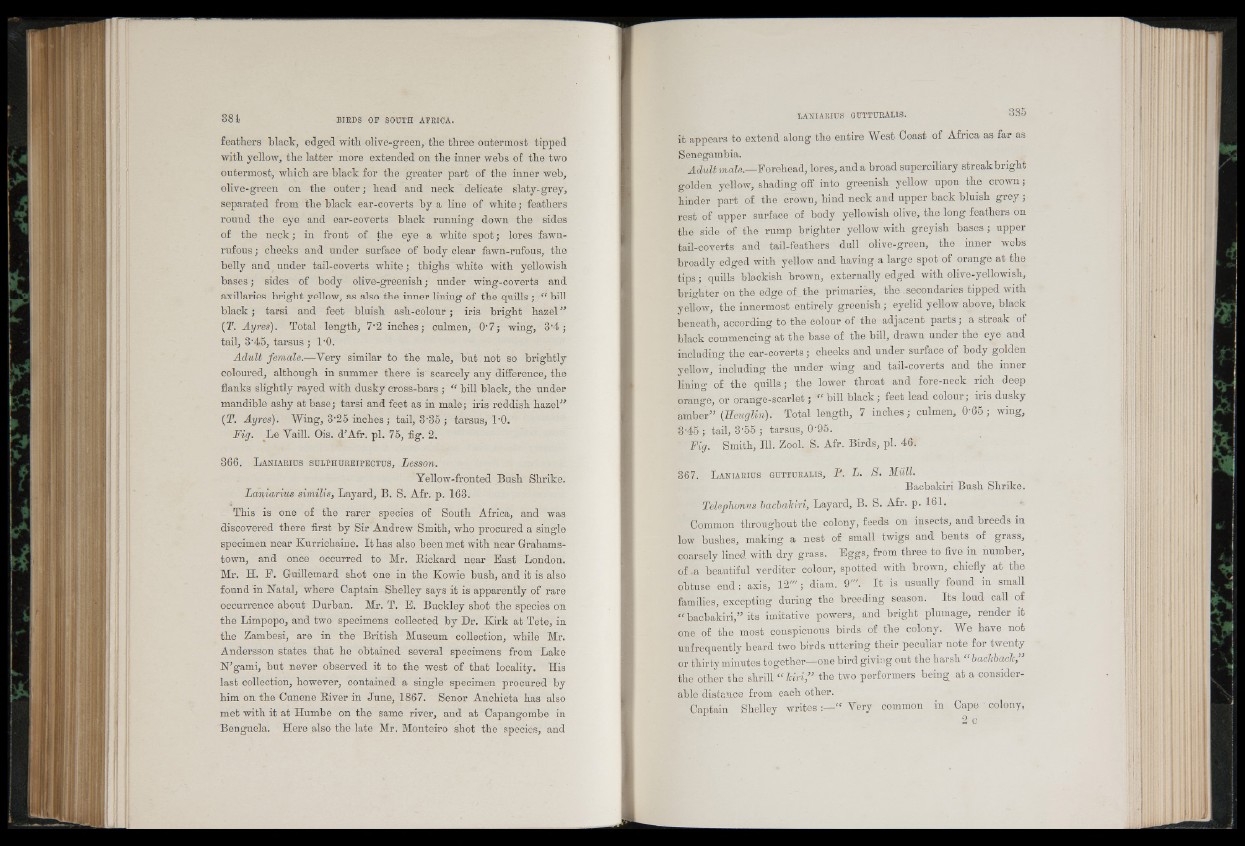
feathers black, edged with olive-green, the three outermost tipped
with yellow, the latter more extended on the inner webs of the two
outermost, which are black for the greater part of the inner web,
olive-green on the outer; head and neck delicate slaty-grey,
separated from the black ear-coverts by a line of white; feathers
round the eye and ear-coverts black running down the sides
of the neck; in front of the eye a white spot; lores fawn-
rufous ; cheeks and under surface of body clear fawn-rufous, the
belly and under tail-coverts white; thighs white with yellowish
bases; sides of body olive-greenish; under wing-coverts and
axillaries bright yellow, as also the inner lining of the quills ; “ bill
black; tarsi and feet bluish ash-colour; iris bright hazel ”
(T. Ayres). Total length, 7'2 inches; culmen, O'7; wing, 3 '4 ;
tail, 3'45, tarsus ; l'O.
Adult female.—Yery similar to the male, but not so brightly
coloured, although in summer there is scarcely any difference, the
flanks slightly rayed with dusky cross-bars ; “ bill black, the under
mandible ashy at base; tarsi and feet as in male; iris reddish hazel”
(T. Ayres). Wing, 3'25 inches; tail, 3'35 ; tarsus, l'O.
Fig. Tie Vaill. Ois. d’Afr. pi. 75, fig. 2.
366. L a niarius su l ph u r e ip e c t u s , Lesson.
Yellow-fronted Bush Shrike.
Lav.iarius similis, Layard, B. S. Afr. p. 163.
This is one of the rarer species of South Africa, and was
discovered there first by Sir Andrew Smith, who procured a single
specimen near Kurrichaine. It has also been met with near Grahams-
town, and once occurred to Mr. Rickard near East London.
Mr. H. P. Guillemard shot one in the Kowie bush, and it is also
found in Natal, where Captain Shelley says it is apparently of rare
occurrence about Durban. Mr. T. E. Buckley shot the species on
the Limpopo, and two specimens collected by Dr. Kirk at Tete, in
the Zambesi, are in the British Museum collection, while Mr.
Andersson states that he obtained several specimens from Lake
N'gami, but never observed it to the west of that locality. His
last collection, however, contained a single specimen procured by
him on the Cunene River in June, 1867. Senor Anchieta has also
met with it at Humbe on the same river, and at Capangombe in
Benguela. Here also the late Mr. Monteiro shot the speciPs, and
it appears to extend along the entire West Coast of Africa as far as
Senegambia.
Adult male.—Forehead, lores, and a broad superciliary streak bright
golden yellow, shading off into greenish yellow upon the crown;
hinder part of the crown, hind neck and upper back bluish grey ;
rest of upper surface of body yellowish olive, the long feathers on
the side of the rump brighter yellow with greyish bases; upper
tail-coverts and tail-feathers dull olive-green, the inner webs
broadly edged with yellow and having a large spot of orange at the
tips; quills bla.ckish brown, externally edged with olive-yellowish,
brighter on the edge of the primaries, the .secondaries tipped with
yellow, the innermost entirely greenish; eyelid yellow above, black
beneath, according to the colour of the adjacent parts; a streak of
black commencing at the base of the bill, drawn under the eye and
including the ear-coverts; cheeks and under surface of body golden
yellow, including the under wing and tail-coverts and the inner
lining of the quills; the lower throat and fore-neck rich deep
orange, or orange-scarlet; bill black; feet lead colour; iris dusky
amber” (Eeuglin). Total length, 7 inches; culmen, 0'65; wing,
3'45 ; tail, 3'55 ; tarsus, 0'95.
' Fig. Smith, 111. Zool. S. Afr. Birds, pi. 46.
367. L a n ia r iu s g u t t u r a l is , P. L. S. Müll.
Bacbakiri Bush Shrike.
Telephonus bacbakiri, Layard, B. S. Afr. p. 161.
Common throughout the colony, feeds on insects, and breeds in
low bushes, making a nest of small twigs and bents of grass,
coarsely lined with dry grass. Eggs, from three to five in number,
of -a beautiful verditer colour, spotted with brown, chiefly at the
obtuse end: axis, 12'"; diam. 9'". It is usually found in small
families, excepting during the breeding season. Its loud call of
“ bacbakiri,” its imitative powers,. and bright plumage, render it
one of the most conspicuous birds of the colony. We have not
unfrequently heard two birds uttering their peculiar note for twenty
or thirty minutes together—one bird giving out the harsh “backback,
the other the shrill " kiri,” the two performers being at a considerable
distance from each other.
Captain Shelley writes “ Yery common in Cape ' colony,